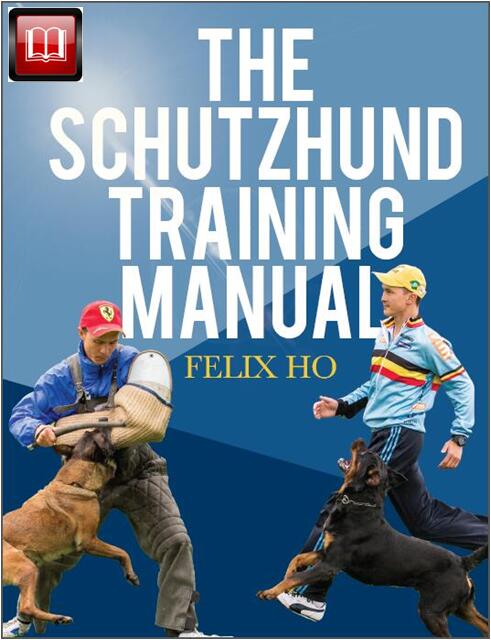The Schutzhund Training Manual Ebook
The Schutzhund Training Manual (English), by Felix Ho
Over 110,000 words;
700 full-colored illustrations;
370 pages;
Six years in the making;
The Schutzhund Training Manual begins with the history of the Schutzhund program, to the explanation of working abilities, pack structure, understanding dog language, puppy selection, training stages and elements for tuning, and the learning phase and strengthening phase of Schutzhund tracking, obedience, and protection.
Packed with insightful and thorough description of the sport and the training of utility canines, this is a must-have handbook for all working dog enthusiasts.
Buy at:
The Schutzhund Training Manual (English), by Felix Ho – Over 110,000 words, 700 full-colored illustrations, 370 pages, six years in the making, The Schutzhund Training Manual begins with the history of the Schutzhund program, to the explanation of working abilities, pack structure, understanding dog language, puppy selection, training stages and elements for tuning, and the learning phase and strengthening phase of Schutzhund tracking, obedience, and protection.
It is a step-by-step guide from puppy upbringing to teaching a dog every single exercise required to achieve his IPO3 title in the finest details. All of the training philosophy and systems in this book has been first-handedly utilized, experimented, and proven by me in practice and on the highest level of Schutzhund/IPO competitions, including nine world championships, seven titled dogs, and three different breeds (Malinois, German Shepherd, Rottweiler).
Packed with insightful and thorough description of the sport and the training of utility canines, this is a must-have handbook for all working dog enthusiasts.
Chapter 1
1. Introduction
2. Working Dogs & Doggy Jobs
3. Brief History & Structure of Schutzhund/IPO
- Minimum Age for a Dog to Enter IPO Trials
- BH
- IPO1
- IPO2
- IPO3
4. Working Abilities
- Interpretation of the 20 Genetic Working Abilities
- Drives
5. Pack Structure
- Understanding Dog Language through the Studies of Wolves
- Wolf Characteristics
- The Five Ranks in a Wolf Pack
- Ranking by Genetics VS Ranking by Human Influence
- The Role of the Handler in the Pack
6. Basic Understanding of Dog Language
- Sight
- Hearing
- Touch
- Smell
- Taste
7. Proper Keeping & Kennel Management of Working Dogs
- Kennels
- Food
- Exercises
- Medical Attention
- Recording
- Training Equipment
Chapter 2
8. Common Working Dog Breeds
9. Puppy Selection
- Breeds & Bloodlines
- Age of Puppy Selection
- Campbell Puppy Evaluation
- Environmental Evaluation
- Bite Evaluation
- Scoring of the Three Evaluations
- Considerable Factors after the Evaluations
- Handler for Dog, Dog for Handler
- Early Talents VS Late Bloomers
- Effectiveness of the Evaluations, Changes that May Occur as the Puppy Grows, Environmental Influences, Instincts VS Moldability
10. Training Stages & Elements for Tuning
- Elements for Tuning
- Training Stages
- Developing Stage
- Learning Stage
- Strengthening Stage
- Stabilizing Stage
- Perfecting Stage
11. Developing Stage: A Puppy’s First Week Home: Part 1
- First Three Days for a Puppy to Settle in with His New Handler: Pack Management, Basic Rules, Exposure, Drive Building, Introduction of the Clicker
- Wolfish Dog, Sheepish Dog, Piggish Dog. The Fairy VS the Devil
- Bite Development
12. Developing Stage: A Puppy’s First Week Home: Part 2
- The Fourth to the Seventh Day for a Puppy to Settle in with His New Handler: Learning to Learn (Free Shaping, Luring, Targeting), Scent Pad
- Positive Reinforcement, Negative Reinforcement
- Reinforcer
- Eight Types of Positive & Negative Reinforcing Techniques
- Working to Achieve, Working to Avoid
- Free Shaping
- Luring
- Targeting
- Avoidance Training: Blocking, Leading, Pressing, & Reverse Targeting
- Things to Remember While Employing Avoidance Training
- A Comprehensive System
- Cross-Training
- Scent Pad
- Training Cycle
- Time Table of a Puppy’s First Week Home: An Example
- IPO Commands in English, German, & Dutch
Chapter 3
13. Tracking Learning Stage
- Winning Criteria in IPO Tracking
- Tracking Training Components Table
- Scent
- Straight Track
- Serpentine
- Progresses until Tracking Strengthening Stage
14. Obedience Learning Stage
- Winning Criteria in IPO Obedience
- Obedience Training Components Table
- Teaching Attention through Free Shaping
- Teaching Sit, Down, Stand, Heel Left, Heel Right, Hold, Release, Jump, Climb, Look Forward, Go Ahead, Target Plates through Luring
- Sit
- Down
- Stand
- Heel Left, Heel Right
- Backward
- Hold
- Release
- Jump
- Climb
- Look Forward, Go Ahead
- Target Plates
- Teaching Front Position through Targeting
- Fetching Toys
- Teaching Release through Pressing
- Contents in One Lesson
- Progresses until Obedience Strengthening Stage
- When to Introduce Verbal Commands?
15. Protection Learning Stage
- Winning Criteria in IPO Protection
- Protection Training Components Table
- Decoys
- The Role of the Handler in Bite Work Training
- Introducing the Decoy
- A Clean & Explosive Out
- Introducing the Clatter Stick
- Using the Clatter Stick to Increase Drive & Confidence
- Clear, Strong, & Rhythmic Barking
- Teaching the Dog to Proactively Challenge an Unequipped Decoy
- Fast, Direct, Purposeful Search of the Hides (Run Around)
- Biting Style
- Teaching the Bite & Pull
- Teaching the Bite & Push
- Developing an Active Pulling Grip or Pushing Grip
- Teaching the Attack
- Leg Bite
- Synopsis of the Learning Stage
Chapter 4
16. Tracking Strengthening Stage
- From “Zigzag” Steps to Normal Steps
- Right Angle Corner
- Teaching the Slow Walk with a Pinch Collar
- Controlling Speed & Precision on the Track with a Pinch Collar
- The Article Indication Box
- Cross Track
- Elements to Work on at Tracking Strengthening Stage
- Memorizing the Track
- Progressing to Trialing Level
- Observing the Dog’s Behaviour in Tracking
17. Obedience Strengthening Stage
Obedience Strengthening Stage 1st Phase
- Sit: Leading, Targeting, Linking the Command
- Down: Leading, Pressing, Targeting, Linking the Command
- Stand: Leading, Reverse Targeting, Linking the Command
- Heel Left, Heel Right: Leading, Targeting, Infusing Hunt Drive/Prey Drive, Reverse Targeting, Linking the Command
- Front Position: Leading, Linking the Command, From Down to Here
- Backward: Reverse Targeting, Linking the Command, Infusing Hunt Drive/Prey Drive
- Hold: The Table Retrieve System
- Release: Luring, Leading
- Target Plates: Leading, Linking the Command
- Jump: Leading, Target Plates, Linking the Command
- Climb: Leading, Target Plates, Linking the Command
- Look Forward, Go Ahead: Leading, Infusing Hunt Drive/Prey Drive
- Blending Food Drive, Hunt Drive/Prey Drive, Pack Drive, Comfort Drive Together, Conditioning the Dog to Rebound after Pressure
Obedience Strengthening Stage 2nd Phase
- Attention: Practice during Sit, Basic Position, & Front Position. Strengthening Attention under Distraction. Using Hunt Drive/Prey Drive to Rebound the Dog after Pressure
- Warming Up before Training
- Familiarizing the Training Field
- Cooling Down after Training
- Contents in One Lesson
- When to Introduce the Pinch Collar in Obedience?
Obedience Strengthening Stage 3rd Phase
- Heeling Off-Leash
- Sit in Motion
- Down in Motion
- Stand in Motion
- Retrieve
- Retrieve Over Hurdle
- Retrieve Over A-Frame
- Send Away
- Down Stay
Obedience Strengthening Stage 4th Phase
- Preparing for BH (Companion Dog Examination)
18. Protection Strengthening Stage
- Choosing the Right Sleeve
- First Step of Introducing Control in Bite Work
- Searching the Hides
- The Pressure Pot Principle
- Hold & Bark
- Prevention of the Escape
- Re-Attack during Guarding
- Back Transport
- Attack during Back Transport
- Long Attack
- Re-Attack during Guarding
- Increasing the Dog’s Practical Protective Abilities
19. Food for Thought
- Special Thanks
About the Author












